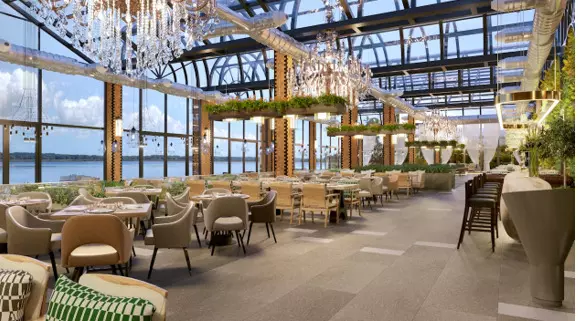Opening a Restaurant: The Power of Design and Smart Technology
image for illustrative purpose

Opening a restaurant is an exciting endeavor that combines culinary vision with business strategy and guest experience. While much of the focus is typically placed on food quality and service, one of the most influential factors in a restaurant’s success is its atmosphere. Interior design plays a major role in how customers perceive a brand, how comfortable they feel, and how likely they are to return. A thoughtfully decorated space does more than just look good—it supports your concept, influences customer behavior, and helps tell your story. In parallel, modern technology, especially restaurant POS systems, ensures that your operations run smoothly behind the scenes.
The foundation of great restaurant design is alignment with your concept. Whether you're opening a rustic Italian trattoria, a sleek sushi bar, or a vibrant vegan café, your decor should reflect the food and experience you promise. This includes color palettes, materials, lighting, artwork, furniture, and layout. For example, earthy tones and natural wood finishes create a cozy, organic feel, while polished metal and minimalism evoke modernity and precision. Design choices should not only support your brand identity but also cater to your target clientele—families, couples, tourists, or professionals.
Good design is also about functionality. The flow of your space impacts both service efficiency and the overall dining experience. Ensure that tables are spaced to allow for privacy without sacrificing capacity, and that the kitchen, bar, and dining areas are arranged to minimize unnecessary movement. Consider the visibility of staff to guests, the acoustics of the room, and the accessibility of all areas. A well-designed restaurant should feel natural to navigate, welcoming to enter, and comfortable to stay in.
Lighting is one of the most powerful tools in restaurant decor. It influences mood, enhances food presentation, and helps define your restaurant's energy. Warm lighting tends to create a relaxed, intimate environment, while bright lighting works well for fast-paced or daytime operations. Use a combination of ambient, task, and accent lighting to highlight architectural features, art, or focal points in your design. Dimmer systems allow for adjusting light levels throughout the day to match the mood or meal period.
When choosing materials, consider both aesthetics and practicality. Surfaces need to be durable, easy to clean, and consistent with your brand tone. Natural stone, reclaimed wood, polished concrete, tile, and stainless steel are all popular choices in modern restaurant design. Fabrics used for seating should be stain-resistant and easy to maintain. Even small design elements—like wall treatments, flooring textures, and tableware—contribute to the overall guest impression.
Decor is also a powerful branding tool. Wall art, signage, color schemes, and even scent can be used to tell your story and create a memorable identity. Custom artwork or installations can reinforce your concept and serve as photo-worthy spots that customers want to share on social media. Cohesive design elements across the space make your brand more recognizable and help you stand out in a competitive market like the restaurant industry.
Design and technology should work hand-in-hand. Many elements of restaurant tech—like self-ordering kiosks, tablet menus, and wall-mounted displays—are visible to customers and should be integrated seamlessly into the space. Back-end systems like point-of-sale platforms also benefit from thoughtful placement. Ensure that cashier stations are easily accessible but discreet, blending with your design without interfering with the aesthetic. Smart lighting, sound systems, and even climate control can be automated and customized based on time of day or occupancy levels.
A restaurant’s point-of-sale system is essential for ensuring efficient operations. From taking orders to managing inventory and tracking sales performance, the POS acts as the nerve center of your business. Gloria Food POS is a modern, cloud-based solution that is perfect for new restaurants. It offers a seamless interface for both staff and management, supporting online orders, real-time data tracking, and menu customization. Because of its simplicity and integration capabilities, Gloria Food POS reduces wait times, minimizes order errors, and provides valuable insights into customer preferences and operational efficiency. Choosing the right POS system like Gloria Food POS allows you to maintain a high level of service consistency while focusing on what matters most—your guests and their experience.
Allocating your budget wisely is crucial when opening a restaurant. Interior design and technology should be viewed as investments, not expenses. While it’s tempting to cut costs on decor or tech during the startup phase, these are the elements that shape customer impressions and operational success. Work with professional designers, contractors, and technology providers to ensure that your space is both beautiful and functional. Plan for ongoing maintenance, software updates, and potential upgrades as your business grows.
Once your design is complete and your systems are in place, it’s time to prepare for the launch. Use soft openings to test workflows, lighting conditions, and guest flow. Gather feedback not just on food and service, but on the ambiance, seating comfort, and overall environment. Adjustments made during this phase can prevent bigger problems down the road. Document your design and operational procedures for training new staff, and ensure everyone is familiar with how to use the POS and any other digital tools.
Opening a restaurant is a complex process, but when design and technology are prioritized together, the results can be exceptional. Your restaurant’s decor sets the tone for the entire experience, while smart systems like Gloria Food POS ensure that everything behind the scenes runs smoothly. By investing in a space that looks great and works efficiently, you create an environment where both staff and guests feel comfortable, engaged, and eager to return.

